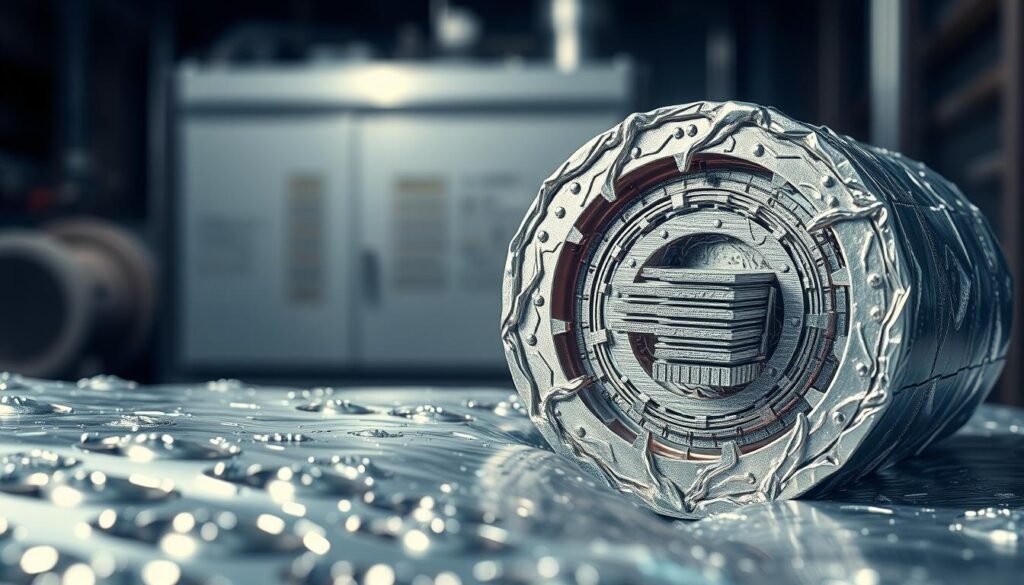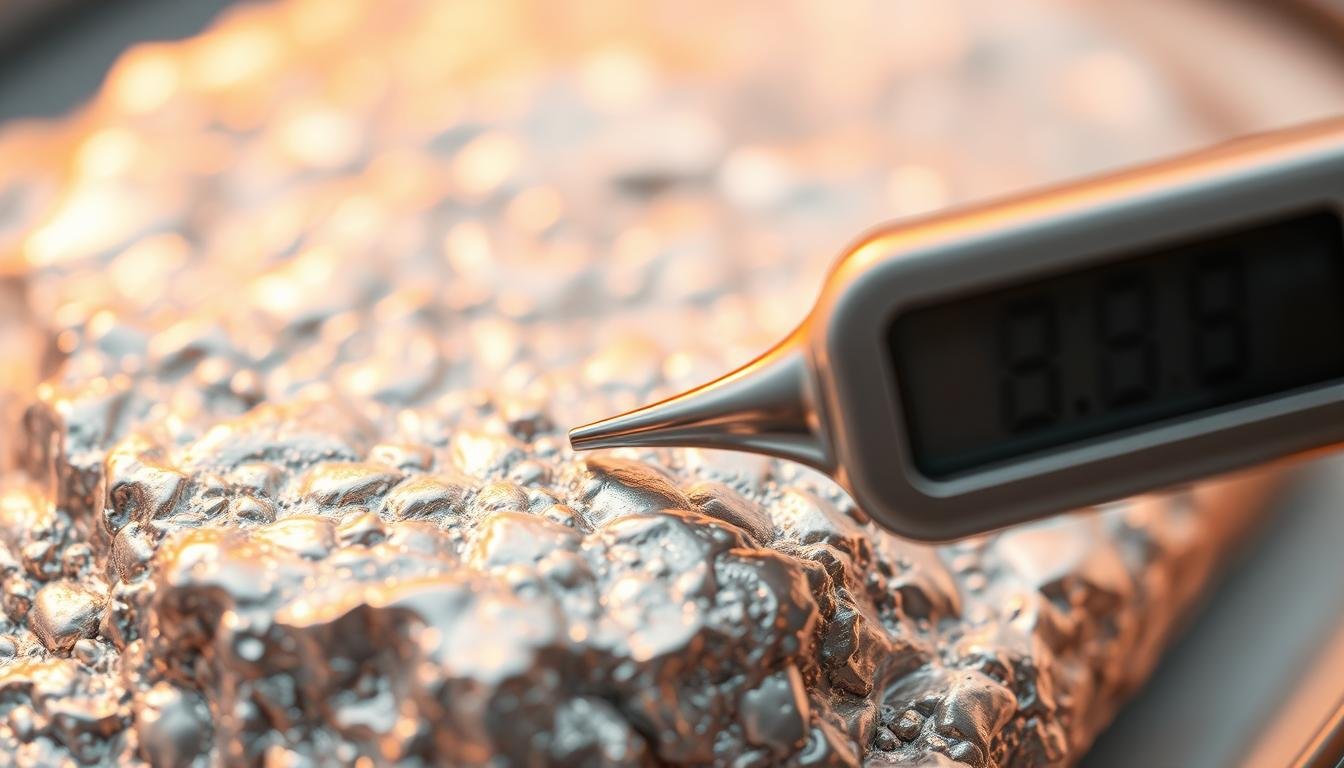Understanding thermal properties is essential when working with precious metals. For professionals in jewelry design, electronics, and manufacturing, knowing precise temperature thresholds ensures quality and efficiency. This guide focuses on a critical characteristic of one of the world’s most versatile elements.
The element Ag (atomic number 47) reaches its phase transition at 961.78°C (1763.2°F). This specific thermal characteristic influences how it’s shaped, purified, and utilized across industries. From intricate jewelry casting to high-performance electrical components, this temperature defines its workability.
Ag’s exceptional conductivity and reflectivity make it invaluable in modern applications. Professionals rely on this threshold to optimize processes like alloy creation and material recycling. Whether refining raw ore or crafting delicate designs, precision matters.
By mastering these thermal behaviors, artisans and engineers achieve consistent results. This knowledge also impacts safety protocols and equipment choices. Stay informed to leverage Ag’s full potential in your projects.
Introduction to Silver and Its Melting Properties
Throughout history, civilizations have prized one metal for its brilliance and versatility. Known scientifically as Ag, this element shines brighter than any other in both practical applications and cultural significance. Its atomic structure – with 47 electrons – creates unmatched thermal conductivity, making it essential for modern technology and traditional craftsmanship alike.
Ag dominates industries ranging from solar energy to medical devices. Jewelers value its malleability, while engineers rely on its ability to transfer heat efficiently. Nearly 80% of this precious metal today serves industrial purposes rather than decorative ones.
What makes Ag truly exceptional? Three key factors stand out:
- Superior electrical performance in circuits and connectors
- Natural antibacterial qualities for water purification systems
- Light-reflecting capabilities in precision mirrors
These characteristics stem from Ag’s unique electron configuration. When heated, its atomic bonds respond predictably – a trait vital for creating alloys and recycling materials. Professionals across fields leverage this behavior to achieve precise results in manufacturing and design.
From ancient coinage to space-grade electronics, Ag’s thermal properties continue shaping human progress. Mastering these traits allows experts to push boundaries in sustainable tech and artistic innovation.
Chemical and Physical Properties of Silver
Group 11 elements on the periodic table demonstrate unique characteristics that define their industrial value. Ag (silver) stands out in this group with its filled 4d electron shell and single 5s valence electron. This atomic configuration enables exceptional electron mobility, contributing to its renowned conductivity.
With a density of 10.503 g/cm³, Ag crystallizes in a face-centered cubic structure. This arrangement allows atoms to slide past each other easily, making the metal highly ductile. While slightly less malleable than gold, it can be pressed into thin sheets or drawn into fine wires without breaking.
Ag’s thermal conductivity outperforms all other metals, reaching 429 W/m·K. This unmatched thermal conductivity makes it indispensable in heat exchangers and advanced cooling systems. Its electrical conductivity also tops metal rankings, explaining why 85% of industrial applications use Ag in electrical contacts and circuit boards.
| Property | Ag | Cu | Au |
|---|---|---|---|
| Density (g/cm³) | 10.503 | 8.96 | 19.32 |
| Thermal Conductivity (W/m·K) | 429 | 401 | 318 |
| Electrical Conductivity (% IACS) | 105 | 100 | 70 |
| Crystal Structure | Face-centered cubic | Face-centered cubic | Face-centered cubic |
Ag readily forms alloys with copper and gold, enhancing durability while maintaining conductive advantages. These combinations prove vital in aerospace components and medical devices where material performance is critical.
Understanding these fundamental properties allows engineers to predict Ag’s behavior under thermal stress accurately. These characteristics, rooted in its position on the periodic table, directly inform manufacturing techniques in applications ranging from electrical contacts to medical implants.
Understanding the Silver Melting Point
The phase change from solid to liquid marks a critical juncture in material processing. Ag transitions at 961.8°C (1,763.24°F), requiring specialized heat sources like induction furnaces. This thermal threshold separates industrial-grade operations from basic metalworking.
Converting this value to 1235K creates universal benchmarks for labs and manufacturers. Standardized measurements ensure consistency when creating alloys or recycling materials. One aerospace engineer notes:
“The Kelvin scale eliminates ambiguity – it’s why we specify 1235K in all spacecraft component manuals.”
Ag’s 1,200°C gap between phase transitions offers practical advantages:
- Extended casting times for detailed jewelry molds
- Stable liquid state during circuit board production
- Efficient purification without vapor loss risks
| Metal | Melting Point (°C) | Boiling Point (°C) | Key Applications |
|---|---|---|---|
| Ag | 961.8 | 2,162 | Electronics, medical devices |
| Cu | 1,085 | 2,562 | Wiring, plumbing |
| Au | 1,064 | 2,856 | Aerospace, nanotechnology |
| Al | 660.3 | 2,470 | Construction, packaging |
Industrial teams use these values to select crucible materials and safety protocols. Gas-fired systems typically achieve 1,000°C+, while electric kilns offer precise control for delicate tasks.
Factors Affecting Silver’s Melting Temperature
Material scientists recognize multiple variables that determine phase transition thresholds in metals. For Ag, these factors range from atomic interactions to manufacturing conditions. Professionals must account for these elements when designing heating processes or alloy formulas.

Purity and Alloy Composition
Pure silver (99.9% Ag) maintains the highest thermal stability. When combined with other metals, its phase transition temperature drops significantly. Sterling silver (92.5% Ag, 7.5% Cu) melts at 893°C – 69°C lower than pure forms.
| Alloy Type | Composition | Melting Temperature |
|---|---|---|
| Fine Silver | 99.9% Ag | 961.8°C |
| Sterling Silver | 92.5% Ag, 7.5% Cu | 893°C |
| Britannia Silver | 95.8% Ag, 4.2% Cu | 930°C |
| Argentium Silver | 93.5% Ag, 5.5% Cu, 1% Ge | 903°C |
Atomic Structure and Metallic Bonding
Ag’s face-centered cubic lattice creates uniform metallic bonds. These electron-sharing connections require specific energy levels to break. Copper additions disrupt this structure, reducing the energy needed for phase changes.
Environmental factors like air pressure or heating speed cause minor variations. Rapid heating might create uneven temperature distribution. Crystal imperfections also affect how heat travels through the material.
Industrial specialists use this knowledge to optimize casting furnaces and recycling systems. A jewelry manufacturer explains:
“We adjust temperatures based on alloy recipes – even 2% copper changes our entire workflow.”
Comparison of Melting Points Among Metals
Metalworkers and engineers prioritize thermal thresholds when selecting materials for projects. This critical factor determines energy requirements, equipment choices, and production timelines across industries.
Thermal Thresholds in Common Elements
Industrial applications demand precise temperature management. Below are key comparisons for popular elements:
| Material | Phase Transition (°C) | Primary Uses |
|---|---|---|
| Copper | 1,084 | Electrical wiring, heat exchangers |
| Gold | 1,064 | Electronics, aerospace components |
| Aluminum | 660 | Packaging, construction |
| Platinum | 1,768 | Catalytic converters, lab equipment |
Copper’s higher thermal stability makes it ideal for high-temperature environments. Gold, though softer, maintains structural integrity closer to 1,000°C – a crucial factor in semiconductor manufacturing.
Lower-melting materials like aluminum enable energy-efficient production. As noted in industry benchmarks, these variations guide alloy development and recycling processes.
Three critical considerations emerge:
- Energy costs decrease with lower transition temperatures
- High-melting metals require specialized furnaces
- Alloy combinations balance durability and workability
A materials engineer explains:
“We select metals based on their phase behavior – even 50°C differences dictate equipment specifications.”
This thermal hierarchy enables professionals to optimize manufacturing workflows while maintaining performance standards.
Silver Alloys and Their Melting Points
Blending Ag with other metals creates materials tailored for specific industrial needs. These combinations alter thermal behaviors while enhancing durability or conductivity. The table below shows how composition affects phase transition temperatures in common silver alloys:
| Alloy Type | Composition | Melting Temperature |
|---|---|---|
| Fine Silver | 99.9% Ag | 961.8°C (1,763.2°F) |
| Sterling Silver | 92.5% Ag, 7.5% Cu | 893°C (1,640°F) |
| Britannia Silver | 95.8% Ag, 4.2% Cu | 940°C (1,724°F) |
| Argentium Silver | 93.5% Ag, 6.5% Cu/Ge | 930°C (1,706°F) |
Sterling silver’s 7.5% copper content lowers its thermal threshold by 68°C compared to pure Ag. Professional jewelers prefer this reduced thermal threshold because it lowers energy costs. It also improves precision during casting processes.
Modern silver alloys like Argentium add germanium to prevent tarnishing. This innovation maintains workability while melting 31°C cooler than fine silver. Brazing compounds take this further – 15% Ag solder flows at 600-650°C, ideal for delicate electronics repair.
Metallurgists blend metals strategically to balance purity and practicality. As one foundry manager notes:
“We adjust alloy recipes like chefs – a 2% copper change alters the entire casting dynamic.”
Types of Silver and Their Specific Melting Temperatures
Craftsmen and engineers select silver varieties based on thermal thresholds required for their projects. Each alloy’s composition determines its phase transition behavior, directly impacting manufacturing processes and final product quality.
Fine Silver
Pure silver (99.9% Ag) maintains the highest thermal stability at 961.8°C. This makes it ideal for medical equipment and laboratory instruments where purity matters most. Its resistance to oxidation ensures consistent performance under repeated heating cycles.
Sterling Silver
The classic 92.5% Ag alloy melts at 893°C – 69°C lower than pure forms. Copper additives enhance durability while reducing energy costs. This balance explains its dominance in jewelry production and decorative arts.
Britannia Silver
With 95.8% Ag content, this variant transitions at 940°C. It bridges the gap between purity and workability, often chosen for commemorative coins and premium tableware. The slightly reduced copper content improves tarnish resistance compared to sterling blends.
Argentium Silver
Modern metallurgy achieves 930°C melting points through germanium additions. This innovation offers superior tarnish resistance while maintaining excellent castability. Manufacturers prefer it for intricate electronic components requiring precise thermal management.
Professionals consult resources like thermal properties of silver alloys when designing production workflows. The 68°C range between common types allows tailored solutions for specific technical demands. Understanding these variations helps optimize furnace settings and material selection across industries.
Industrial Applications of Melting Silver
Modern industries harness Ag’s transformative capabilities across diverse fields. From artistic creation to advanced technology, controlled thermal processes unlock this metal’s full potential. Professionals balance tradition with innovation, shaping both cultural artifacts and future-forward solutions.
Jewelry, Decorative Arts, and Bullion Production
Master artisans rely on precise thermal control to craft intricate jewellery designs. The metal flows seamlessly into molds, capturing filigree details for heirloom-quality rings and pendants. High-value tableware and commemorative coins demand similar precision, with purity levels affecting both aesthetics and market value.
Bullion production uses large-scale furnaces to create standardized bars and ingots. These materials form the backbone of global precious metal markets. Decorative applications extend to stained glass coloration and ornamental mirrors, where Ag’s reflectivity enhances visual impact.
Technological and Industrial Uses
Ag’s conductivity makes it indispensable in solar panels and circuit board manufacturing. Over 90% of crystalline silicon photovoltaic cells use Ag-based pastes for efficient energy transfer. The metal is also used in water purification systems, leveraging its natural antimicrobial properties.
Advanced applications include aerospace window coatings and X-ray film production. Medical devices benefit from Ag’s non-toxic surface treatments, while catalytic converters rely on its reactive qualities. These diverse uses demonstrate why industries continue innovating with this versatile element.
